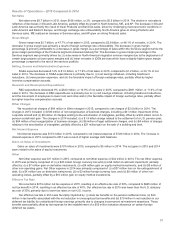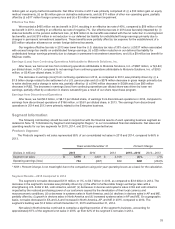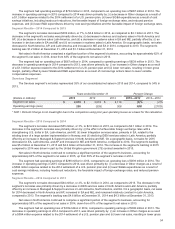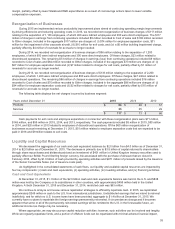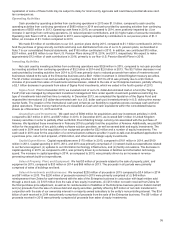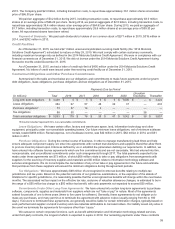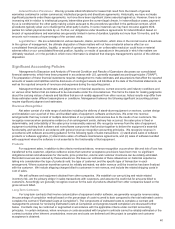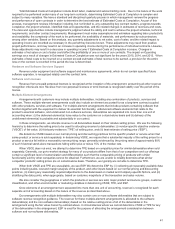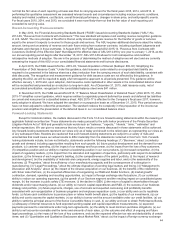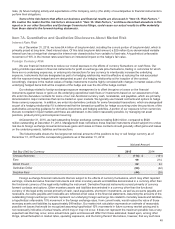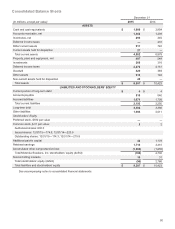Motorola 2015 Annual Report Download - page 42
Download and view the complete annual report
Please find page 42 of the 2015 Motorola annual report below. You can navigate through the pages in the report by either clicking on the pages listed below, or by using the keyword search tool below to find specific information within the annual report.41
Total Estimated Costs at Completion include direct labor, material and subcontracting costs. Due to the nature of the work
required to be performed under many of our long-term contracts, determining Estimated Costs at Completion is complex and
subject to many variables. We have a standard and disciplined quarterly process in which management reviews the progress
and performance of open contracts in order to determine the best estimate of Estimated Costs at Completion. As part of this
process, management reviews information including, but not limited to, any outstanding key contract matters, progress towards
completion, the project schedule, identified risks and opportunities, and the related changes in estimates of revenues and costs.
The risks and opportunities include management's judgment about the ability and cost to achieve the project schedule, technical
requirements, and other contract requirements. Management must make assumptions and estimates regarding labor productivity
and availability, the complexity of the work to be performed, the availability of materials, and performance by subcontractors,
among other variables. Based on this analysis, any quarterly adjustments to net sales, cost of sales, and the related impact to
operating income are recorded as necessary in the period they become known. These adjustments may result from positive
project performance, and may result in an increase in operating income during the performance of individual contracts. Likewise,
these adjustments may result in a decrease in operating income if Estimated Costs at Completion increase. Changes in
estimates of net sales or cost of sales could affect the profitability of one or more of our contracts. The impact on Operating
earnings as a result of changes in Estimated Costs at Completion was not significant for the years 2015, 2014, and 2013. When
estimates of total costs to be incurred on a contract exceed estimates of total revenue to be earned, a provision for the entire
loss on the contract is recorded in the period the loss is determined.
Hardware and Software Services Support
Revenue under equipment and software support and maintenance agreements, which do not contain specified future
software upgrades, is recognized ratably over the contract term.
Software and Licenses
Revenue from pre-paid perpetual licenses is recognized at the inception of the arrangement, presuming all other revenue
recognition criteria are met. Revenue from non-perpetual licenses or term licenses is recognized ratably over the period of the
license.
Multiple-Element Arrangements
Arrangements with customers may include multiple deliverables, including any combination of products, services and
software. These multiple-element arrangements could also include an element accounted for as a long-term contract coupled
with other products, services and software. For multiple-element arrangements that include products containing software that
function together with the equipment to deliver its essential functionality, undelivered software elements that relate to the
product's essential software, and undelivered non-software services, deliverables are separated into more than one unit of
accounting when: (i) the delivered element(s) have value to the customer on a stand-alone basis and (ii) delivery of the
undelivered element(s) is probable and substantially in our control.
In these arrangements, we allocate revenue to all deliverables based on their relative selling prices. We use the following
hierarchy to determine the selling price to be used for allocating revenue to deliverables: (i) vendor-specific objective evidence
(“VSOE”) of fair value, (ii) third-party evidence (“TPE”) of selling price, and (iii) best estimate of selling price (“ESP”).
We determine VSOE based on our normal pricing and discounting practices for the specific product or service when that
same product or service is sold separately. In determining VSOE, we require that a substantial majority of the selling prices for a
product or service fall within a reasonably narrow pricing range, generally evidenced by the pricing rates of approximately 80%
of such historical stand-alone transactions falling within plus or minus 15% of the median rate.
When VSOE does not exist, we attempt to determine TPE based on competitor prices for similar deliverables when sold
separately. Generally, our go-to-market strategy for many of our products differs from that of our competitors and our offerings
contain a significant level of customization and differentiation such that the comparable pricing of products with similar
functionality sold by other companies cannot be obtained. Furthermore, we are unable to reliably determine what similar
competitor products’ selling prices are on a stand-alone basis. Therefore, we typically are not able to determine TPE.
When both VSOE and TPE are unavailable, we use ESP. We determine ESP by: (i) collecting all reasonably available data
points including sales, cost and margin analysis of the product, and other inputs based on our normal pricing and discounting
practices, (ii) making any reasonably required adjustments to the data based on market and Company-specific factors, and (iii)
stratifying the data points, when appropriate, based on customer, magnitude of the transaction and sales volume.
We also consider the geographies in which the products or services are sold, major product and service groups, customer
classification, and other environmental or marketing variables in determining VSOE, TPE, and ESP.
Once elements of an arrangement are separated into more than one unit of accounting, revenue is recognized for each
separate unit of accounting based on the nature of the revenue as described above.
Our arrangements with multiple deliverables may also contain one or more software deliverables that are subject to
software revenue recognition guidance. The revenue for these multiple-element arrangements is allocated to the software
deliverable(s) and the non-software deliverable(s) based on the relative selling prices of all of the deliverables in the
arrangement using the fair value hierarchy outlined above. In circumstances where we cannot determine VSOE or TPE for any
of the deliverables in the arrangement, ESP is used for the purpose of allocating the arrangement consideration between
software and non-software deliverables.


